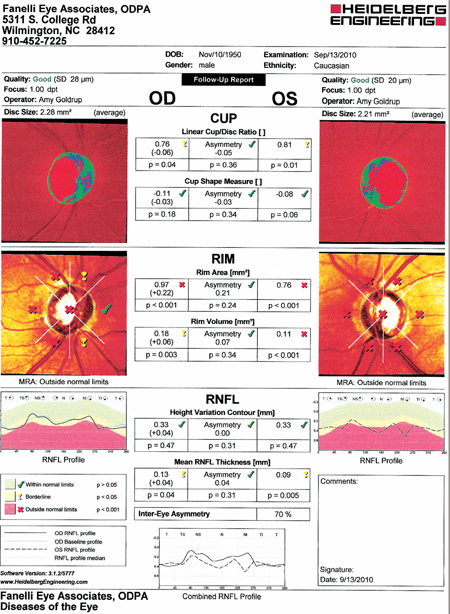 A 59-year-old white male presented to the office in early September 2010 for a second opinion regarding his blurred vision at both distance and near. The patient presented to another physician in March 2010 with a chief complaint of blurred vision. However, the patient was informed that his eyes were healthy, and was given an updated spectacle Rx.
A 59-year-old white male presented to the office in early September 2010 for a second opinion regarding his blurred vision at both distance and near. The patient presented to another physician in March 2010 with a chief complaint of blurred vision. However, the patient was informed that his eyes were healthy, and was given an updated spectacle Rx.
His medical history included only a childhood tonsillectomy. The patient reported that he was taking no medications, and he reported no allergies of any kind.
Diagnostic Data
At the initial visit at our office, his best-corrected visual acuity was 20/20 O.D., O.S. and O.U. through hyperopic astigmatic correction. His pupils were equally round and reactive to light and accommodation, with no afferent defect.
A slit lamp examination of his anterior segments was remarkable for bilateral comedones that were located along the medial aspect of both upper lids as well as bilateral pingueculae that were located temporally and nasally. His anterior chamber angles were estimated to be grade 4 open O.U. by Van Herick’s method.
His intraocular pressure measured 40mm Hg O.D. and 36mm Hg O.S. at 11:30 a.m. Upon pachymetry testing, his central corneal thicknesses (CCT) measured 591µm O.D. and 595µm O.S.
Following dilation, both crystalline lenses were characterized by minimal incipient nuclear sclerosis that was consistent with his age. We noted bilateral floaters O.U.
Stereoscopic disc evaluation demonstrated significant glaucomatous optic neuropathy in both eyes. More specifically, his cup-to-disc ratio was 0.75 x 0.85 O.D. and 0.80 x 0.90 O.S., with extremely thin temporal neuroretinal rims O.U.

We obtained both Heidelberg Retina Tomograph-3 (HRT-3, Heidelberg Engineering) optic nerve images and stereo optic nerve photos of our patient. The HRT-3 images confirmed the clinical appearance of bilateral glaucomatous optic neuropathy and depressed retinal nerve fiber layer thicknesses.
Both macular evaluations were essentially unremarkable, except for some retinal pigment epithelium windows located outside the foveal avascular zone O.U. The peripheral retinal evaluations were unremarkable in both eyes.
We obtained both Heidelberg Retina Tomograph-3 (HRT-3, Heidelberg Engineering) optic nerve images and stereo optic nerve photos. The HRT-3 images confirmed the clinical appearance of bilateral glaucomatous optic neuropathy and depressed retinal nerve fiber layer thicknesses.
We scheduled the patient for a two-week follow-up to reevaluate his IOP and perform formal threshold visual field testing. When the patient returned two weeks later, his IOP was 39mm Hg O.D. and 38mm Hg O.S. at 10:45 a.m. Standard automated perimetry demonstrated dense superior and inferior arcuate scotomas (O.S.>O.D.). The field defects involved fixation. A reassessment of the optic nerves was consistent with the initial visit. Gonioscopy revealed grade 3+ open angles, with moderate trabecular pigmentation in both eyes. There were no angle abnormalities in either eye, and the trabecular pigmentation was symmetric.
We diagnosed the patient with open-angle glaucoma, and started him on a regimen of 1gtt Lumigan (bimatoprost, Allergan) h.s. O.U. We scheduled a two-week follow-up to assess the effects of prostaglandin therapy.
Discussion
What would your initial reaction be upon seeing this patient for the first time? He was seen just a few months earlier by another physician. And, it seems fairly likely that he had glaucoma at that time, especially considering the present levels of elevated IOP and optic nerve damage. Does your blood pressure go up? Do you call the previous provider? Do you obtain the previous medical records? What do you tell the patient? Other than thinking “ouch,” how do you proceed?
This case, in a sense, is a good example of “forensic optometry.” Is it possible that the patient did not have glaucoma when he was seen six months earlier? Yes, it’s possible––but, exceedingly unlikely.
With open angles, IOP would not have risen to that level (40mm Hg) and caused that much optic nerve damage (0.90 vertical cupping) and field loss in such a short a period of time. Given his relatively thick CCT measurements, it would be reasonable to assume that he may have had an IOP in the mid to upper 20s for some time in the past. For this patient, such IOP readings could be relatively “normal” and not cause any optic nerve damage. But, without question, an IOP of 40mm Hg––even with relatively thick CCTs—is excessive.
Bottom line: Our patient’s previous provider failed to diagnose his glaucoma. So, knowing that, what do you say to the patient?
My suggestion is to tell the patient what you know––not what you suspect. Confine your comments to the case and problem at hand. “Mr. Jones, you have
glaucoma. There is damage to your optic nerves that has resulted in some vision loss. In your case, it is related to elevated eye pressures. I am going to give you a prescription eye drop that I want you to begin using in both eyes tonight. The medication will be the first step in stabilizing your condition.” Period––end of sentence.
There are always “what ifs” in life as well as in medicine. What if the patient had previously been told that he needed to be evaluated for glaucoma, and for whatever reason, he chose not to proceed? What if the patient was told that he had elevated IOP throughout his 30s and 40s, followed-up with his former provider regularly, was told that his ocular health was stable, and ultimately became noncompliant with his follow-ups? While he denied the existence of either situation, both are legitimate possibilities. But, what if, for whatever reason, he is not exactly truthful in this regard, and is now skirting around his own culpability?
My gut tells me that he was telling the truth, and that his glaucoma was undiagnosed by his previous eye care provider. But, what if my gut reaction is wrong?
While we can needlessly burden ourselves with the “what ifs” in this case, I believe that the patient is best served by proper management of the known problems––namely the optic nerve and field damage. Though the knee-jerk reaction may be to disparage his previous physician, you must rise above that, care for the patient, and be the best clinician you can be. By doing that, you won’t be asking yourself: “What if it is my patient that Fanelli is writing about?”

